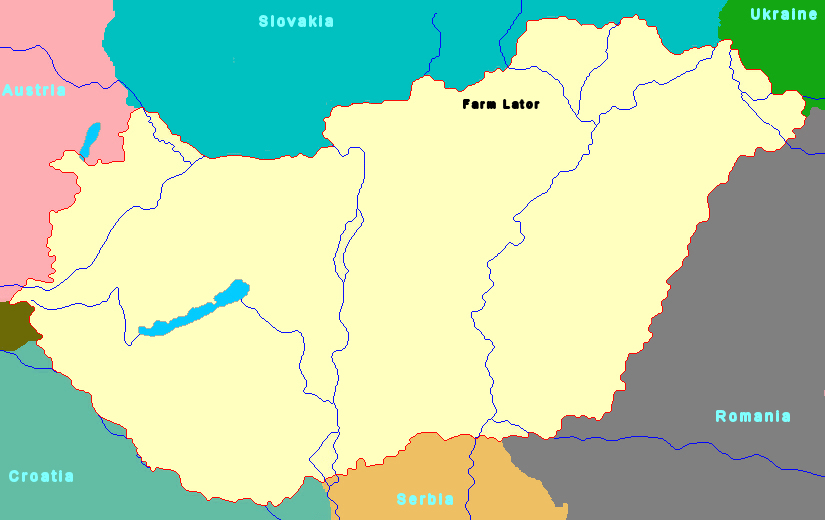Hungary

Historie
Middle Paleolithic presence of Homo heidelbergensis is evidenced by the discovery of the "Samu" fossil, dated to c. 300.000
years old, with traces of habitation as old as 500.000 years ago. Presence of anatomically modern humans dates to c. 33.000 years ago.
The Bronze Age begins with the Vucedol culture c. 3000 BC.
The Iron Age commenced around 800 BC, associated with "Thraco-Cimmerian" artefact types, representing the overlap of the
pre-Scythian (Novocherkassk culture) and pre-Celtic (Hallstatt culture) cultural spheres.
The Roman Empire conquered territory west of the Danube River between 35 and 9 BC. From 9 BC to the end of the 4th century AD,
Pannonia, the western part of the Carpathian Basin, was part of the Roman Empire.
After the Western Roman Empire collapsed in the 5th century AD under the stress of the migration of Germanic tribes and Carpian pressure,
the Migration Period continued to bring many invaders into central Europe, beginning with the Hunnic Empire (c. 370–469).
After the disintegration of Hunnic rule, the Ostrogoths, who had been vassalized by the Huns, established their own Ostrogothic kingdom.
In the 560s the Avars founded the Avar Khaganate, a state that maintained supremacy in the region for more than two centuries and
had the military power to launch attacks against its neighboring empires. The Avar Khaganate was weakened by constant wars and outside pressure,
and the Franks under Charlemagne defeated the Avars in a series of campaigns during the 790s.
Árpád was the leader who unified the Magyar tribes via the Covenant of Blood, forging what was thereafter known as the Hungarian
nation. He led the new nation to the Carpathian Basin in the 9th century.
The Kingdom of Hungary came into existence in Central Europe when Stephen I, Grand Prince of the Hungarians, was crowned king in
1000. The Árpád dynasty produced monarchs throughout the 12th and 13th centuries.
In 1241–1242, the kingdom of Hungary suffered a major blow in the wake of the Mongol invasion of Europe. After Hungary was invaded by
the Mongols in 1241, the Hungarian army was defeated disastrously at the Battle of Mohi.
Royal power was restored under Charles I (1308–1342), a scion of the Capetian House of Anjou.
The expansion of the Ottoman Empire reached the kingdom under Sigismund of Luxemburg (1387–1437). In the next decades, a talented
military commander, John Hunyadi directed the fight against the Ottomans. His victory at Nándorfehérvár in 1456 stabilized
the southern frontiers for more than half a century.
After the Ottomans achieved their first decisive victory over the Hungarian army at the Battle of Mohács in 1526, their forces conquered
large parts of the kingdom of Hungary and continued their expansion until 1556.
Following the Battle of Mohács, the Kingdom of Hungary became divided between the Ottoman Empire encroaching from the East and the Habsburg
Monarchy which had inherited the title of King of Hungary.
The Siege of Buda (4 May to 21 August 1541) ended with the capture of the city of Buda, by the Ottoman Empire, leading to 150 years of
Ottoman control of Hungary.
The Great Turkish War was a series of conflicts between the Ottoman Empire and the Holy League consisting of the Habsburg Empire,
Poland-Lithuania, Venice and Russia. Intensive fighting began in 1683 and ended with the signing of the Treaty of Karlowitz in 1699.
The war was a defeat for the Ottoman Empire, which for the first time lost large amounts of territory. It lost lands in Hungary and Poland, as
well as part of the western Balkans. The war was also significant in that it marked the first time Russia was involved in a western European
alliance. The new territories were united with the territory of Kingdom of Hungary, and became a part of the Habsburg Monarchy.
On 15 March 1848, mass demonstrations in Pest and Buda enabled Hungarian reformists to push through a list of 12 demands. Under governor and
president Lajos Kossuth and the first Prime Minister, Lajos Batthyány, the House of Habsburg was dethroned.
The Austro-Hungarian Compromise of 1867 established the dual monarchy of Austria-Hungary. The two realms were governed separately
by two parliaments from two capital cities, with a common monarch and common external and military policies.
After the assassination of Archduke Franz Ferdinand in Sarajevo, the Hungarian prime minister István Tisza and his cabinet tried to
avoid the outbreak and escalating of a war in Europe, but their diplomatic efforts were unsuccessful. Austria–Hungary drafted
9 million soldiers in World War I on the side of Germany, Bulgaria and Turkey.
On November 11, 1918, World War I ended for Austria-Hungary with a complete military loss. With the collapse of the army, Austria-Hungary also
collapsed. The ethnic groups of Kingdom of Hungary called for independent nation-states. In the Treaty of Trianon signed on June 4, 1920,
Hungary lost two-thirds of its territory.
Hungary formally entered World War II as an Axis Power on 26 June 1941, declaring war on the Soviet Union after unidentified planes
bombed Kassa, Munkács, and Rahó. Hungarian troops fought on the Eastern Front for two years. Despite some early successes, the Hungarian
government began seeking a secret peace pact with the Allies after the Second Army suffered catastrophic losses at the River Don in January 1943.
By October 1944, the Soviets had reached the river Tisza, and despite some losses, succeeded in encircling and besieging Budapest in December.
Following the defeat of Nazi Germany, Hungary became a satellite state of the Soviet Union.
The Soviet leadership selected Mátyás Rákosi to front the Stalinization of the country, and Rákosi de facto ruled Hungary
from 1949 to 1956.
On 14 May 1955, the Soviet Union created the Warsaw Pact, binding Hungary to the Soviet Union and its satellite states in Central and
Eastern Europe. Among the principles of this alliance were "respect for the independence and sovereignty of states" and "non-interference
in their internal affairs"
The Hungarian Revolution of 1956 was a nationwide revolution against the Hungarian People's Republic and its Soviet-imposed policies. The
revolt began as a student protest, which attracted thousands as they marched through central Budapest to the Hungarian Parliament building,
calling out on the streets using a van with loudspeakers. On 4 November, a large Soviet force invaded Budapest and other regions of the country.
Hungary's transition from communism to democracy and capitalism was peaceful and prompted by economic stagnation, domestic political pressure,
and changing relations with other Warsaw Pact countries.
Free elections were held in May 1990, and the Hungarian Democratic Forum, a major conservative opposition group, was elected to the head of a
coalition government. József Antall became the first democratically elected Prime Minister since World War II.
After the 2010 parliamentary elections, Viktor Mihály Orbán is serving as Prime Minister of Hungary.
I have visited Hungary in august 2018
These are the places I have seen on that trip
Farm Lator
Please let me know when you're having questions.
i would be pleased to help you.
Things to do and other tips
